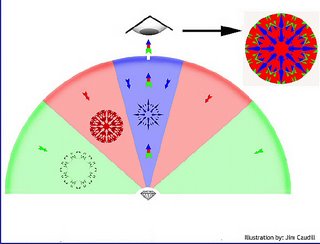Diamond Cut Analysis - The A.S.E.T. Tool
 The science of diamond cut analysis is advancing rapidly with new computer programs and optical measuring devices. The GIA has been studying diamond cut for 15 years and in January of this year released it's first ever cut grading system for round brilliant cut diamonds. The AGSL has been issuing cut grades on their reports for round diamonds since 1996 and as a result AGSL is the lab best known for cut grading. The AGS "triple zero" became the gold standard for the ideal cut since inception and AGSL will continue to play a dominant role in the study of diamond cut for many years to come. AGSL has recently begun issuing cut grades on princess cut diamonds and soon will do so for emerald cut diamonds . Both GIA and AGS have contributed enourmously to the understanding of how faceted diamonds reflect and refract light and how that performance is perceived by the human eye.
The science of diamond cut analysis is advancing rapidly with new computer programs and optical measuring devices. The GIA has been studying diamond cut for 15 years and in January of this year released it's first ever cut grading system for round brilliant cut diamonds. The AGSL has been issuing cut grades on their reports for round diamonds since 1996 and as a result AGSL is the lab best known for cut grading. The AGS "triple zero" became the gold standard for the ideal cut since inception and AGSL will continue to play a dominant role in the study of diamond cut for many years to come. AGSL has recently begun issuing cut grades on princess cut diamonds and soon will do so for emerald cut diamonds . Both GIA and AGS have contributed enourmously to the understanding of how faceted diamonds reflect and refract light and how that performance is perceived by the human eye.In the course of these studies and development of their respective grading systems several tools have been developed to help quantify performance. Perhaps none has more far reaching implications than the AGS A.S.E.T. tool. The ASET (angular spectrum evaluation tool) is based upon the understanding that light enters the diamond from different angles in the viewing environment and those angles have an effect on the amount and quality of light that is returned to the eye. The ASET tool is an amazingly simple viewing device that produces a color coded view of the light coming from a diamond.
The image of the diamond that is displayed in the device serves as a graphical snapshot or "map" which gives the viewer a very good indication of how the diamond is handling light from these various angles and if potential performance is being lost due to light leakage. The ASET tool is not only an easy test that anyone can quickly learn to use to evaluate diamond cut performance, but it is really an integral part of AGS cut grading system as it can be used to test light performance for any diamond shape. It also serves as an identification tool as each diamond has a unique pattern.

Both GIA and AGS systems recognize that the beauty of a faceted diamond results from several distinct optical aspects such as brightness, contrast, dispersion (fire) and pattern of the facets. The ASET tool can give the observer a very quick assessment of overall light performance in a diamond without knowing any dimensions or angles. There is an inexpensive hand held model available as well as more sophisticated desktop models equipped for photography.
In addition, if the exact measurements of all the key elements of the diamond are known, those numbers can be input into several computer programs which will generate an ASET image. This image then distills all the data into a single point of reference that consumers as well as experts can easily understand.
For many reasons the ASET is likely to be a key tool in the analysis of diamond cut for many years to come.

